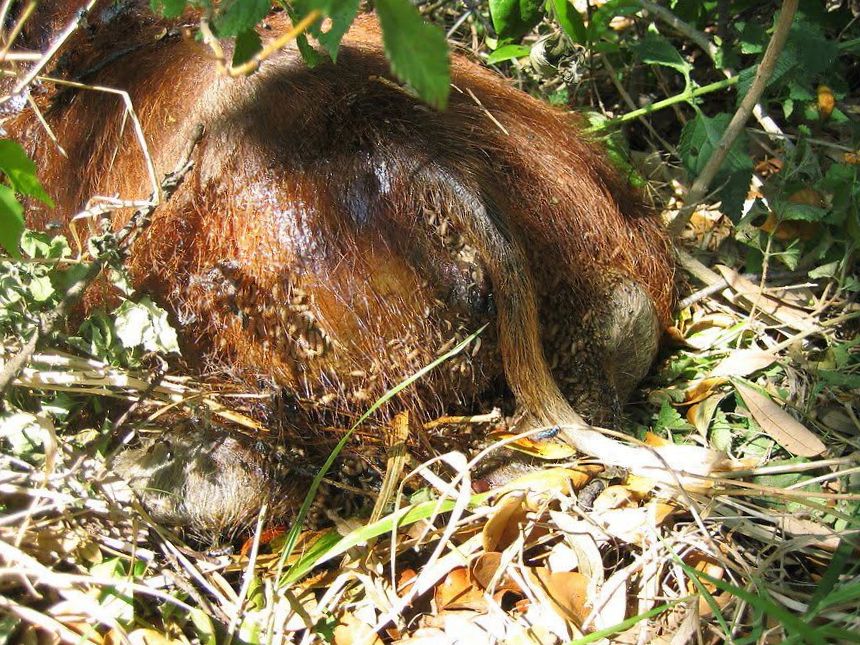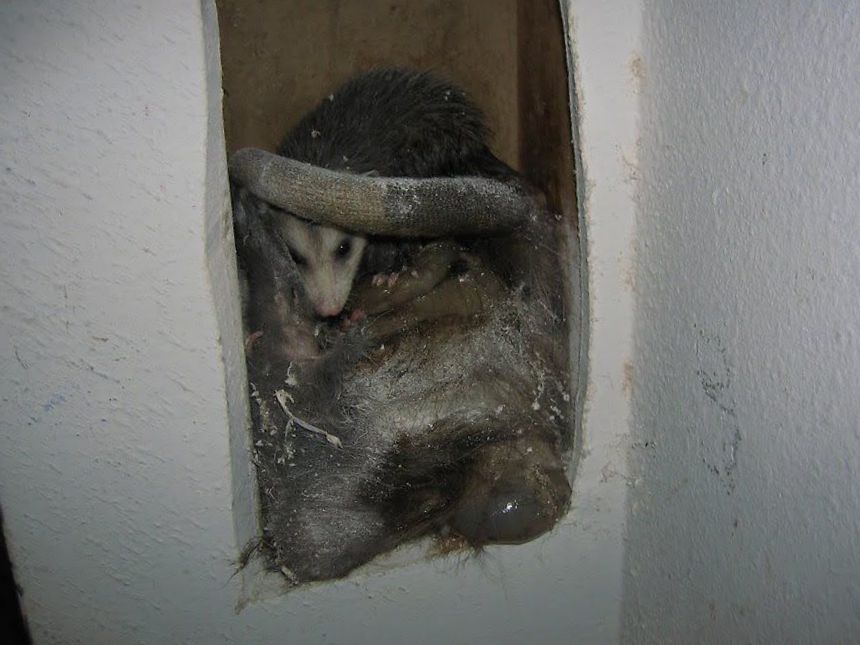- info@pestcontrolwildlife.com
Call us for help in your town
America's Wildlife Experts
Dead Animals

What Animals Die in a House?
nuisance animal that has the opportunity to get inside your home has the opportunity to die inside of it, and your removal and control actions could even contribute to the death of the animal.
When you have large populations of animals, such as bats in a colony, or rats in a pack, it is almost inevitable that you will encounter a dead individual at some point or another. Old age, disease, and other factors will have a part to play in it; the natural circle of life.
Performing the wrong control and removal approach can also lead to the death of one or more animals, something that we commonly find with inexperienced DIY'er's who haven't done enough research. Using exclusion devices on wildlife families is never a good idea: you will simply lock parents out, babies in, and eventually the latter group will die without parental care.
Using poison almost always causes death inside homes and other buildings. Despite what you may have read on the internet or product packaging, rodenticide does NOT make rats and mice go outside to die. More often than not, they'll die right inside your home.
What Are the Problems With Dead Animals in a House?
After a while, the body of that dead animal will start to decompose, a process that can be made quicker with hot temperatures and moist spaces. It won't take long for a bad odor to start lingering around, and if the animal has died in a vent or duct system, you may find that the smell is pumped all around your home or building.
That scent will do more than just make you unhappy, too; it'll also act as a signal to other animals, letting scavengers and insects know that there's a tasty meal waiting for them. It won't be long until flies join the party, and an array of other pests will jump in right behind them — including rats and mice, potentially.
Dead animals also pose problems by releasing fluids, which can stain and discolor surfaces and materials and can also drip or seep through into other floors.
Can Dead Animals Still Spread Rabies and Other Diseases?
Yes, dead animals CAN still spread rabies and other diseases. The virus itself is believed to be quite fragile and won't live outside of a living, wet host for very long, but moist biological material can still contain enough of the virus for transmission to occur.
Rabies isn't the only disease you'll need to concern yourself with when it comes to dead animals in your home. There are countless diseases linked to nuisance wildlife, and many of the disease-causing pathogens are present in the carcass of the animal, still transmittable for a period of time after death, as well as in urine, droppings, and other materials. There are even pathogens that turn into airborne particles once they dry out, such as those associated with histoplasmosis.

Where Will You Find Dead Animals in a House?
The worst part about getting rid of dead animals in the home is trying to find them — and they can get into all sorts of places, some of which you might not even be aware of. Wall cavities seem to be a particular ‘dying spot' for rodents, squirrels, and bats, but we have found countless species actually inside the wall. In a lot of cases, we need to cut the wall, remove the carcass, and the repair the damage we have just caused once full decontamination and cleanup has been completed.
We have personally encountered dead animals in the follow places: basements, crawl spaces, wall cavities, in the attic, under roof tiles, in the chimney, behind and under kitchen appliances, under the bath, in the sofa, under porches and decking, beneath the stairs, in window wells, under bushes in the back yard, in drain pipes, in various segments of air conditioning and heating units, and many more places besides.
In short: nuisance wildlife can die ANYWHERE in your home. If they can get to the place, they can die there.
How to Find and Remove Dead Animals
Your nose and sense of smell is going to be your best friend when it comes to finding and then removing dead animals in your home. The stronger the smell, the closer you are to where that animal is — although it might not be obvious right away. You could be standing right next to a dead animal in the wall cavity beside you and not realize it … until you actually cut out a piece of that wall, of course.
In order to keep yourself safe, you will need to protect yourself with an assortment of items, including full coveralls, boot covers, thick gloves, eye protection, a breathing mask, and plenty of bags in which you can throw material to be incinerated or otherwise responsibly disposed of. Everything you used to clean up or remove that dead animal, and any mess it might've left behind, will need to be fully sanitized after use, or thrown out and then replaced. It takes just the tiniest biological trace to spread potentially deadly diseases ... and those biological traces are completely invisible to the human eye.
How to Get Rid of Dead Animal Smell
Getting rid of the bad smells that dead animals leave behind is very much down to a process of cleaning and ventilating; without both of those things, there's a high chance the smell will linger.
The job is not a pleasant one. In a lot of cases, it will be necessary for you to squeeze into tight, cramped, hot, and very uncomfortable spots of the building, reaching to try and clean a contaminated area properly to avoid re-infestation and the spread of disease.
Once the animal has been removed (it will not work if you do not remove it), you must make sure that ALL disease threats are removed. This will include biological material, such as droppings, urine, dead animals, baby animals, etc; and also potentially contaminated non-biological material, such as attic insulation used for nesting, chewed material, den-stuffing material, etc.
Once all of that has been removed, it's time to clean and ventilate, using strong biological enzyme cleaners that break down the invisible threats. In doing so, the odor is broken down too. You should also consider using a disinfectant, as well as an odor removal product -- but don't mix and match cleaning products as this can lead to toxic gases and potentially harmful effects.


















